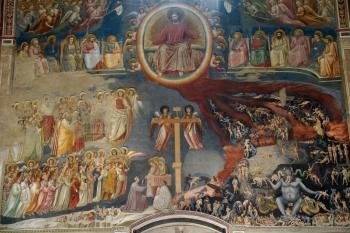Hubert 3.5
Padua’s fourteenth-century fresco cycles
Padua’s fourteenth-century fresco cycles (Inscribed)

There is broad agreement among the reviewers on this website that the Scrovegni Chapel deserves a place on the World Heritage List and I can only emphasize once again the magnificence of these paintings. The Scrovegni Chapel was on the Italian tentative list as a single monument since the late 1990s, but it was never nominated. Recent activities suggest that things now get going: in January 2016, the T-list entry has been extended to include eight additional sites with frescoes from the 14th century, and it was reported that Padua is working on the nomination dossier and a management plan.
The Scrovegni Chapel is still the focus of the nomination: "It represents the most significant monument in the proposed series and the best-preserved fresco painting by Giotto” (cited from the T-list entry). Giotto di Bondone is the most famous artist of the Trecento (i.e. art and architecture of the 14th century in Italy) and an important forerunner of Renaissance. He introduced visual perspective in painting, his frescoes have spatial depth by the use of landscapes and architectural elements in the background, his characters are not static and flat, they show gestures and posture and individuality, Giotto "painted from life". The other sites of this serial nomination show frescoes by Giotto’s lesser-known successors. This website provides detailed information on the nine sites: locations, opening times, descriptions of the artworks and even audioguide tracks.
I visited the Scrovegni Chapel for the first time in 2004, and a weekend in Padua in August 2016 gave me the opportunity to visit also the other sites (only the Cappella della Reggia Carrarese was closed).
A few comments on the individual sites:
The Scrovegni Chapel is definitely the highlight. The entrance is via the Musei Civici agli Eremitani, I would recommend to pre-book tickets online. A visit takes about 30 minutes, it starts with an introductory film and then you can visit the chapel for 15 minutes in a group of 25 people. This restriction is an appropriate way to manage the rush of visitors, it allows to admire all the details and colouring of the magnificent frescoes without jostling. To my surprise, it was allowed to take photos, this was not the case ten years ago, if I remember correctly, and is forbidden in several of the other sites.
Musei Civici agli Eremitani (admission is included in the fee for the chapel): works of Trecento artists are shown in two rooms, including a painted cross by Giotto. I was most impressed by the cycle of angel panels by Guariento. It has been discussed in the forum, whether "movable" and "detached" objects can be part of a WHS or not, see here.
Chiesa agli Eremitani: next to the museum, with frescoes in the apsis, partly damaged in WWII, free entry.
Battistero della Cattedrale: another highlight, entirely decorated with wonderful frescoes by Menabuoi, most notable are the paintings in the dome, no photos allowed.
Palazzo della Ragione: in the centre of Padua, with a striking roof construction and a huge hall in the upper floor; however, the dimensions of the hall (80 metres in length) are more impressive than the paintings.
The Basilica of Saint Anthony is a very popular pilgrimage site because of the tomb of Saint Anthony of Padua, so the frescoes are of minor importance for most visitors. There are numerous services throughout the day, but only the chancel and the central nave are closed to normal visitors. Most impressive: the Belludi Chapel with frescoes by Menabuoi.
Oratorio di San Giorgio: next to the basilica, entirely covered with frescoes by Altichiero da Zevio and one of the best sites of this nomination.
Oratorio di San Michele: on the outskirts of the old town, the frescoe cycle is partly fragmented, in my opinion the least impressive part of the nomination.
Finally, the question: Has the proposal been strengthened by the extension to a serial nomination? In general, I am more in favour of single monuments than of comprehensive thematic approaches, also in this case. The outstanding value of the Scrovegni Chapel is indisputable and as a single monument it would be a representative example of the Trecento on the WH list. Having said that, I must admit that some of the other parts of the nomination are also extraordinary works of art and well worth a visit, especially the Oratorio di San Giorgio and the Battistero della Cattedrale. And if the extension increases the chances for the Scrovegni Chapel to get inscribed, I would have no objections.
Comments
No comments yet.
